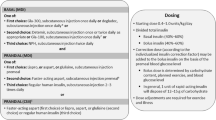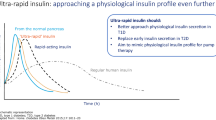Abstract
Attention to meal-related insulin replacement in type 2 diabetes is important as insulin deficiency progresses. The physiology in type 2 and type 1 diabetes differs, and optimal use of basal-bolus therapy in type 2 diabetes requires attention to such issues as the role for oral medications, residual endogenous insulin, and differing meal patterns in older and more obese individuals.
Similar content being viewed by others
References and Recommended Reading
Turner RC, Cull CA, Frighi V, Holman RR: Glycemic control with diet, sulfonylurea, metformin, or insulin in patients with type 2 diabetes mellitus: progressive requirement for multiple therapies (UKPDS 49). UK Prospective Diabetes Study (UKPDS) Group. JAMA 1999, 281:2005–2012.
Rosenbloom AL, Joe JR, Young RS, Winter WE: Emerging epidemic of type 2 diabetes in youth. Diabetes Care 1999, 22:345–354.
Hillier TA, Pedula KL: Complications in young adults with early-onset type 2 diabetes. Diabetes Care 2003, 26:2999–3005.
Mudaliar SR, Lindberg FA, Joyce M, et al.: Insulin aspart (B28 aspinsulin): a fast-acting analog of human insulin: absorption kinetics and action profile compared with regular human insulin in healthy nondiabetic subjects. Diabetes Care 1999, 22:1501–1506.
Homko C, Deluzzio A, Jimenez C, et al.: Comparison of insulin aspart and lispro: pharmacokinetic and metabolic effects. Diabetes Care 2003, 26:2027–2031.
Roach P, Yue L, Arora V: Improved postprandial glycemic control during treatment with Humalog Mix25, a novel protamine-based insulin lispro formulation: Humalog Mix25 Study Group. Diabetes Care 1999, 22:1258–1261.
Weyer C, Heise T, Heinemann L: Insulin aspart in a 30/70 premixed formulation: pharmacodynamic properties of a rapid-acting insulin analog in stable mixture. Diabetes Care 1997, 20:1612–1614.
Yki-Jarvinen H, Ryysy L, Nikkila K, et al.: Comparison of bedtime insulin regimens in patients with type 2 diabetes mellitus: a randomized, controlled trial. Ann Intern Med 1999, 130:389–396.
Riddle MC, Rosenstock J, Gerich J: The treat-to-target trial. Diabetes Care 2003, 26:3080–3086.
Feinglos MN, Thacker CH, English J, et al.: Modification of postprandial hyperglycemia with insulin lispro improves glucose control in patients with type 2 diabetes. Diabetes Care 1997, 20:1539–1542.
Landstedt-Hallin L, Adamson U, Arner P, et al.: Comparison of bedtime NPH or preprandial regular insulin combined with glibenclamide in secondary sulfonylurea failure. Diabetes Care 1995, 18:1183–1186.
Bastyr EJ, Stuart C, Brodows RG, et al.: Therapy focused on lowering postprandial glucose, not fasting glucose, may be superior for lowering HbA1c. Diabetes Care 2000, 23:1236–1241.
Henry RR, Gumbiner B, Ditzler T, et al.: Intensive conventional insulin therapy for type II diabetes. Metabolic effects during a 6-month outpatient trial. Diabetes Care 1993, 16:21–31.
Yki-Jarvinen H, Kauppila M, Kujansuu E, et al.: Comparison of insulin regimens in patients with non-insulin-dependent diabetes mellitus. N Engl J Med 1992, 327:1426–1433.
Riddle MC, Schneider J: Beginning insulin treatment of obese patients with evening 70/30 insulin plus glimepiride versus insulin alone. Glimepiride Combination Group. Diabetes Care 1998, 21:1052–1057.
Wulffele MG, Kooy A, Lehert P, et al.: Combination of insulin and metformin in the treatment of type 2 diabetes. Diabetes Care 2002, 25:2133–2140.
Strowig SM, Aviles-Santa ML, Raskin P: Comparison of insulin monotherapy and combination therapy with insulin and metformin or insulin and troglitazone in type 2 diabetes. Diabetes Care 2002, 25:1691–1698. Demonstrates advantages to using metformin and troglitazone in the setting of aggressive insulin therapy.
Strowig SM, Aviles-Santa ML, Raskin P: Improved glycemic control without weight gain using triple therapy in type 2 diabetes. Diabetes Care 2004, 27:1577–1583. Follow-up to previous study showing benefits to using both oral medications in setting of aggressive insulin therapy.
Hermansen K, Colombo M, Storgaard H, et al.: Improved postprandial glycemic control with biphasic insulin aspart relative to biphasic insulin lispro and biphasic human insulin in patients with type 2 diabetes. Diabetes Care 2002, 25:883–888.
Bretzel RG, Arnolds S, Medding J, Linn T: A direct efficacy and safety comparison of insulin aspart, human soluble insulin, and human premix insulin (70/30) in patients with type 2 diabetes. Diabetes Care 2004, 27:1023–1027.
Raskin P, Bode BW, Marks J, et al.: Continuous subcutaneous insulin infusion and multiple daily injection therapy are equally effective in type 2 diabetes. Diabetes Care 2003, 26:2598–2603.
Cefalu WT, Skyler JS, Kourides IA, et al.: Inhaled human insulin treatment in patients with type 2 diabetes mellitus. Ann Intern Med 2001, 134:203–207.
Kim D, Mudaliar S, Chinnapongse S, et al.: Dose-response relationships of inhaled insulin delivered via the Aerodose insulin inhaler and subcutaneously injected insulin in patients with type 2 diabetes. Diabetes Care 2003, 26:2842–2847.
Thompson RG, Gottlieb A, Organ K, et al.: Pramlintide: a human amylin analogue reduced postprandial plasma glucose, insulin and C-peptide concentrations in patients with type 2 diabetes. Diabet Med 1997, 14:547–555.
Fineman M, Bicsak TA, Shen LZ, et al.: Effect on glycemic control of exenatide (synthetic exendin-4) additive to existing metformin and/or sulfonylurea treatment in patients with type 2 diabetes. Diabetes Care 2003, 26:2370–2377.
Juhl CB, Hollingdal M, Sturis J, et al.: Bedtime administration of NN2211, a long-acting GLP-1 derivative substantially reduces fasting and postprandial glycemia in type 2 diabetes. Diabetes 2002, 51:424–429.
Koro CE, Bowlin SJ, Bourgeois N, Fedder DO: Glycemic control from 1988 to 2000 among U.S. adults diagnosed with type 2 diabetes. Diabetes Care 2004, 27:17–20.
Author information
Authors and Affiliations
Rights and permissions
About this article
Cite this article
Karl, D.M. The use of bolus insulin and advancing insulin therapy in type 2 diabetes. Curr Diab Rep 4, 352–357 (2004). https://doi.org/10.1007/s11892-004-0037-1
Issue Date:
DOI: https://doi.org/10.1007/s11892-004-0037-1




